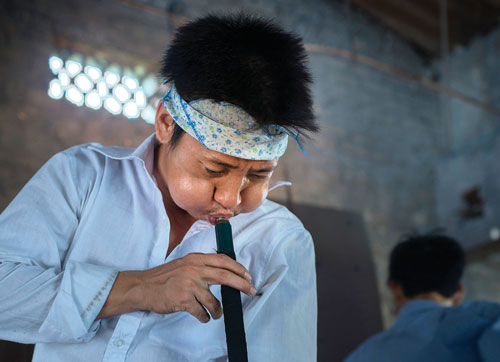(No.3, Vol.7,Jun-Jul 2017 Vietnam Heritage Magazine)



At a glass kiln,
Xoi Chi Village,
Nam Dinh Province
Photos: Trinh Thu Nguyet
The golden age of
glass-blowing long past, a faithful few artisans struggle to keep their craft alive
70 years ago, Mr Pham Van Dao left Xoi Chi village to earn a living for his family. Quite a while afterward, he returned with glass-blowing skills. He immediately opened a glass kiln and passed down the trade secrets to his descendants. Having mastered the trade, they established their own business. Gradually, Xoi Chi became a busy trade village producing glass cups, bottles, and lamp bowls.
At peak seasons such as near to Lunar New Year, trade at Xoi Chi was heated by merchants from Ha Noi and adjacent provinces.
1985-1995 was the golden time of glass trade at Xoi Chi. Surrounded by purely farming villages, 85 per cent of Xoi Chi villagers engaged in the glass trade. Having established a business, the next most important job of the owner is to build a glass-melting kiln. It is usually built by the owner himself using the best clay. An average kiln is 1.2m high and 1m wide.
While waiting for the kiln to dry, the owner and dozens of workers wash waste glass so that the product they will make will be bubble-free. The washing is very low-tech; they wash the glass in a huge tank the way housewives wash vegetables. The glass bought from waste collectors for about VND1,000/kg is then classified by colour.
Next, they put glass of the same colour into the kiln and ignite the pit-coal. About 6 hours later, when the temperature in the kiln reaches 1,800oC, the glass begins to melt.
At this time, workers use a special iron pipe to scoop the glass out at one end and then blow the pipe from the other end. Filled with the air from the worker’s lungs, the red-hot glass slowly swells like a blooming flower and takes the shape of bottles, vases, cups, lamp bowls etc. depending on the mould.
‘Just scoop and blow. Sounds so simple, but it is not, not at all. To make a good product that looks good, the worker needs a lot of experience and skills. Most importantly, the amount and speed of the air flow has to be measured correctly,’ Mr Pham Cong Linh, great grandson of Mr Dao said.
To make a 30-liter decanter, a worker has to scoop about 5kg of red-hot glass and blow continuously for 10 minutes. The product having taken the desired form, the worker waits for it to get below burning temperature, and then covers it with thatch to cool down slowly for 12 hours, making it more durable. The finished product should have a correct form, smooth surface, be free of bubbles, and have a regular thickness.
Working constantly beside a white-hot kiln, the workers are always drenched in sweat, even in cold winters.
They work on batch after batch of glass until the kiln is broken. They take a few days off waiting for the new kiln to be built, and then get back to work again. Every day, each kiln consumes 700-800kg of waste glass, producing about 1000 products. The cheapest piece is worth a few hundred dongs, the highest-priced ones may be up to VND300,000.
Since the year 2000, every year, several Xoi Chi glass kiln owners quit the trade. The village currently has only three glass kilns. A kiln owner told us the main reason for people quitting is that cheap industrial glass products are flooding the market.
To face the challenges, the remaining glass makers at Xoi Chi constantly reduce cost, improve quality and diversify their product. Facing tough competition in sales, the remaining Xoi Chi glass kiln owners said, ‘No matter how much sweat and pain it takes, we are determined to move on with our forefathers’ trade.’
The fate of Xoi Chi trade village and its hundreds of workers is shared by the other remaining glass-making villages of Vietnam.

